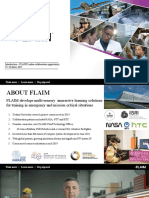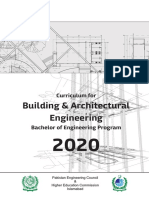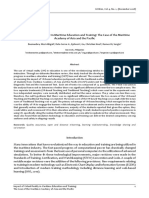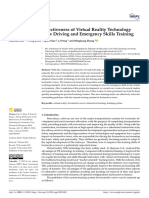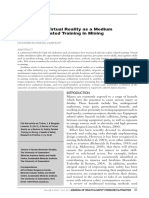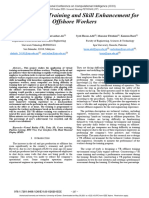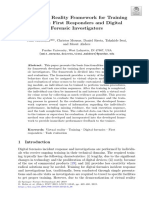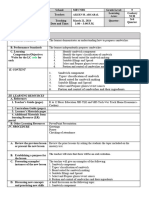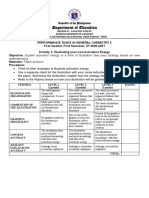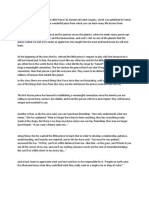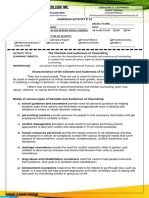Enhancing Health, Safety, Security & Environment (HSSE) Training Through Virtual Reality: An Offshore Emergency Evacuation Exercise
Enhancing Health, Safety, Security & Environment (HSSE) Training Through Virtual Reality: An Offshore Emergency Evacuation Exercise
Volume 9, Issue 11, November – 2024 International Journal of Innovative Science and Research Technology
ISSN No:-2456-2165 https://doi.org/10.38124/ijisrt/IJISRT24NOV598
Enhancing Health, Safety, Security &
Environment (HSSE) Training through Virtual
Reality: An Offshore Emergency Evacuation Exercise
Hayyiratul Fatimah Mohd Zaid*1; Khairulazhar Jumbri2
1
Chemical Engineering Department, 2Fundamental and Applied Sciences Department,
Universiti Teknologi PETRONAS, 32610 Seri Iskandar, Perak, Malaysia
Abstract:- The offshore oil and gas industry poses obstacles. The goal of the exercise is to improve students'
unique safety challenges, particularly during response times, enhance hazard recognition, and reinforce
emergencies such as fires, where quick and effective proper emergency procedures in a safe and controlled
evacuation is critical. This paper explores the use of environment.
virtual reality (VR) technology in Health, Safety,
Security, and Environment (HSSE) training, specifically The application of VR in education, particularly for
through a VR exercise developed for the emergency safety training, has gained significant traction in recent
evacuation scenario on an offshore platform at years. In high-risk industries like offshore oil and gas, VR
Universiti Teknologi PETRONAS (UTP). The exercise allows trainees to experience emergency scenarios without
focuses on training students to safely evacuate the the dangers associated with traditional training (Freina &
platform during a fire emergency, navigating through Ott, 2015). Studies show that VR simulations can enhance
realistic escape routes while avoiding hazards. The decision-making skills, improve hazard recognition, and
study evaluates the effectiveness of VR in enhancing foster better retention of emergency procedures by
students’ situational awareness, response times, and providing realistic, immersive experiences (Smith et al.,
overall preparedness for real-world emergency 2014).
situations. The results demonstrate that VR-based
training significantly improves understanding of In the context of HSSE training, traditional methods
evacuation procedures and decision-making under such as physical drills and classroom training often fail to
stress, offering a valuable tool for HSE education in fully replicate the complex and dynamic nature of real-
high-risk industries. world emergencies (Burke et al., 2006). VR, on the other
hand, can simulate various emergency situations in a
Keywords:- Virtual Reality (VR), Health, Safety, Security, controlled environment, enabling students to practice their
and Environment (HSSE), Emergency Evacuation, Offshore response in a way that traditional training cannot. Previous
Platform Training, Simulation-Based Training. research has demonstrated that VR is an effective tool for
improving safety awareness and preparedness, particularly
I. INTRODUCTION in sectors like offshore operations, where quick, accurate
decision-making is crucial for minimizing risks and
The offshore oil and gas industry is inherently preventing accidents (Gutierrez et al., 2007).
hazardous, with complex operational environments that
require rigorous training in emergency response. One of the The VR exercise simulates an offshore platform
most critical skills for offshore personnel is the ability to environment during a fire emergency. The simulation
evacuate the platform safely and quickly in the event of a includes realistic features such as fire hazards, smoke,
fire or other emergency. Traditional training methods, emergency alarms, and escape routes. Students wear VR
including classroom instruction and physical drills, may not headsets that immerse them in the scenario, allowing them
fully simulate the high-pressure, life-or-death scenarios to explore the virtual platform and practice evacuation
encountered during actual emergencies. Virtual reality procedures. Students must identify and navigate the nearest
(VR), however, offers a promising solution by immersing emergency exits while avoiding hazardous areas and
students in realistic simulations that replicate the intensity obstacles in the fire-affected zones.
of offshore fire emergencies without the associated risks
(Borsci et al., 2016). The exercise is designed to test the students' ability to
respond quickly and correctly under pressure, focusing on
A VR exercise was developed as part of the HSSE key HSE objectives: recognizing hazards, making informed
course to train students in emergency evacuation decisions, and ensuring safe evacuation. Data collected
procedures. This exercise requires students to navigate a from students during the exercise includes evacuation
virtual offshore platform during a simulated fire, times, choices made during the simulation, and overall
identifying and using the nearest emergency exits while performance in following the correct evacuation routes.
avoiding hazardous conditions such as smoke, fire, and
IJISRT24NOV598 www.ijisrt.com 823
Volume 9, Issue 11, November – 2024 International Journal of Innovative Science and Research Technology
ISSN No:-2456-2165 https://doi.org/10.38124/ijisrt/IJISRT24NOV598
To assess the effectiveness of the VR training, pre-
and post-exercise surveys were administered to measure
students' knowledge of evacuation procedures.
Additionally, performance data from the VR exercise were
analyzed to evaluate improvements in response time,
decision-making, and hazard identification.
II. METHODOLOGY
The VR exercise developed for HSSE course at
Universiti Teknologi PETRONAS (UTP) is designed to
simulate an offshore platform environment during a fire
emergency. The simulation includes several key areas of
the platform, including the control room (crane and
drilling), accommodations, and helipad. The exercise Fig 2: VR Evacuation from the Control Room
focuses on guiding students through emergency evacuation
routes while avoiding hazards like smoke and fire. The VR
simulation provides students with a first-person
perspective, allowing them to navigate through the platform
and practice evacuation procedures under realistic
conditions. Figure 1 illustrates the fire exit exercise VR
introduction.
Fig 3: VR Evacuation from Accommodation
Helipad: Students are shown the helipad area, which
serves as a critical point for emergency evacuation by
air. The video describes how to reach the helipad safely
Fig 1: Fire Exit Exercise VR Introduction and the role it plays in evacuations, particularly in
scenarios where water transport or other exits are
A. Pre-Exercise Video Briefing inaccessible. Figure 4 illustrates the VR evacuation
Before engaging in the VR simulation, students are from the helipad.
shown a video briefing to familiarize them with the layout
of the platform and the key areas they will encounter during
the exercise. This video provides an overview of the entire
offshore platform, including:
Control Room: Students are introduced to the control
room, including key operations related to crane and
drilling operations. The video highlights the importance
of staying aware of the control room’s location and
understanding its proximity to other platform areas
during an emergency. Figure 2 shows the VR
evacuation from the control room.
Accommodations: The accommodations area is
presented, detailing where personnel would typically
stay, sleep, and socialize on the platform. This section
of the video emphasizes safe evacuation routes from
living quarters, especially in the event of an emergency. Fig 4: VR Evacuation from the Helipad.
Figure 3 illustrates the VR evacuation from
accommodation.
IJISRT24NOV598 www.ijisrt.com 824
Volume 9, Issue 11, November – 2024 International Journal of Innovative Science and Research Technology
ISSN No:-2456-2165 https://doi.org/10.38124/ijisrt/IJISRT24NOV598
The video briefing aims to ensure students have a B. Performance in the VR Exercise
basic understanding of the platform’s layout and are Post-training analysis showed significant
familiar with key landmarks they will need to recognize improvements in evacuation times and decision-making.
during the VR exercise. This initial briefing also helps to The average evacuation time decreased by 40% after the
reduce the cognitive load during the actual exercise, video briefing, compared to pre-training baseline
allowing students to focus more on the emergency assessments. Students were also able to identify safe escape
procedures and decision-making involved. routes more quickly, and the majority correctly avoided
hazardous areas, such as fire-affected zones or blocked
B. Free-Run Walkthrough of the Scenario paths. Specifically, 87% of students correctly identified the
Following the video briefing, students will enter the most efficient exit route, compared to only 65% before the
VR environment for the free-run walkthrough of the fire VR exercise. The students' ability to recognize hazards,
emergency scenario. In this phase, students are tasked with such as blocked exits or smoke-filled corridors, also
navigating the offshore platform during a simulated fire improved dramatically, with 80% of students demonstrating
emergency, locating the nearest emergency exits, and increased hazard awareness. Table 1 tabulates the
identifying potential hazards such as smoke-filled corridors, comparison of pre- and post-training evacuation times.
blocked pathways, or fire-affected areas.
Table 1: Comparison of Pre- and Post-Training Evacuation
The students are expected to make decisions based on Times
the conditions they encounter during the simulation, such as Group Average Percentage
choosing the quickest route to an exit or determining Evacuation Time Change
whether certain pathways are too dangerous to use. The (Minutes)
simulation provides immediate feedback on their choices, Pre-training 8.5 -
offering insights into whether their selected route was the Post-training (after 5.1 -40%
most efficient or if they missed critical safety checkpoints. video briefing)
Data from the students' interactions within the VR C. Challenges and Limitations
environment, including evacuation times, route choices, While the VR exercise improved students' response
and overall performance, are collected for analysis. This times and hazard recognition, there were some challenges
data helps assess the effectiveness of the VR training in to address. A small portion of students (approximately
improving students' emergency response times and hazard 12%) reported experiencing mild discomfort, such as
identification skills. motion sickness or visual fatigue, during the simulation.
This issue is consistent with findings from previous studies
III. RESULTS AND DISCUSSION highlighting the challenges of VR technology, particularly
for long-duration sessions or certain VR hardware
The integration of the pre-exercise video briefing into configurations (Stevenson et al., 2008). However, these
the VR training significantly enhanced the students' issues were temporary, and no students reported severe
performance during the emergency evacuation exercise. symptoms that would impact their ability to complete the
Feedback from students indicated that the video helped exercise.
them better understand the layout of the platform and the
key landmarks, which allowed for smoother navigation Moreover, while the video briefing helped students
during the VR simulation. This aligns with previous studies understand the layout of the platform, some students still
suggesting that familiarizing trainees with the environment faced difficulty navigating in the VR environment,
before immersion improves performance and reduces stress especially when encountering unfamiliar landmarks under
during high-pressure situations (Stanney et al., 2003). pressure. This highlights the importance of providing
adequate training and support for students before
A. Impact of Video Briefing conducting VR exercises.
Survey results revealed that 92% of students found the
video briefing to be beneficial in helping them understand D. Overall Effectiveness
the platform layout, which in turn improved their Despite these challenges, the overall effectiveness of
confidence when navigating the VR environment. Students VR-based training was evident. Students reported feeling
noted that knowing the locations of critical areas, such as more confident in their ability to evacuate an offshore
the control room, accommodations, and helipad, allowed platform during a fire emergency. The immersive nature of
them to make quicker and more informed decisions during VR provided an engaging, realistic environment that
the simulation. For instance, students were able to promoted active learning and retention of key safety
immediately identify the helipad as a critical exit point, concepts. The pre-exercise video briefing complemented
reducing the time spent searching for evacuation routes. the VR training by reducing cognitive load, which allowed
students to focus more on emergency procedures and less
on spatial orientation.
IJISRT24NOV598 www.ijisrt.com 825
Volume 9, Issue 11, November – 2024 International Journal of Innovative Science and Research Technology
ISSN No:-2456-2165 https://doi.org/10.38124/ijisrt/IJISRT24NOV598
IV. CONCLUSION [6]. Stevenson, M., Zeltzer, D., Katz, L. (2008).
Improving virtual HSE training in offshore
The integration of a VR exercise with a pre-exercise applications. Journal of Occupational Health
video briefing has proven to be an effective approach in Psychology, 13(3), 325-335.
enhancing Health, Safety, Security, and Environment [7]. Stanney, K. M., Hale, K. S., & Ritter, W. A. (2003).
(HSSE) training for offshore emergency evacuations at Virtual reality in HSE: Effects on training
Universiti Teknologi PETRONAS (UTP). The video efficiency. Human Factors, 45(1), 147-158.
briefing, which familiarizes students with the platform
layout, coupled with the immersive VR simulation,
significantly improved students' response times, hazard
awareness, and decision-making skills during the
emergency evacuation scenario.
Overall, the results of this study underscores the
potential of VR technology to revolutionize HSSE training
in high-risk industries. VR not only provides a safe and
engaging environment for students to practice emergency
evacuation procedures but also enables them to experience
real-world scenarios in a way that traditional training
methods cannot. While technical challenges, such as
motion sickness, were observed, the overall positive impact
of VR on students' preparedness for offshore emergencies
makes it a valuable tool in HSSE education. Future
improvements in VR hardware and simulation design will
likely reduce these challenges and further enhance the
training experience.
ACKNOWLEDGMENT
The authors would like to acknowledge the Chemical
Engineering Department and Fundamental & Applied
Sciences Department, Universiti Teknologi PETRONAS
and the Centre for Excellence in Teaching and Learning
(CETaL) Universiti Teknologi PETRONAS.
REFERENCES
[1]. Borsci, S., Lawson, G., Broome, S., et al. (2016).
The role of user-centered design within HSE
training: Investigating user needs for VR simulation.
International Journal of Industrial Ergonomics, 55,
71-85.
[2]. Burke, M. J., Sarpy, S. A., Smith-Crowe, K., et al.
(2006). Relative effectiveness of worker safety and
health training methods. American Journal of Public
Health, 96(2), 315-324.
[3]. Freina, L., & Ott, M. (2015). A literature review on
immersive virtual reality in education: State of the
art and perspectives. eLearning and Software for
Education (eLSE) Conference Proceedings, 133-
141.
[4]. Gutierrez, M. A., Vexo, F., Thalmann, D. (2007).
Stepping into VR: Applications for industrial
training. IEEE Computer Graphics and Applications,
27(4), 16-23.
[5]. Smith, S. P., & Ericson, E. (2014). Using immersive
game-based VR simulations in HSE education:
Analysis and trends. Journal of Safety Research, 49,
47-55.
IJISRT24NOV598 www.ijisrt.com 826
You might also like
- Draft 1 Study Proposal c1 3 Canlas 2 (1) RevisedNo ratings yetDraft 1 Study Proposal c1 3 Canlas 2 (1) Revised35 pages
- Examining the Use of Virtual Reality (VR) Technology in Health and Safety Training within Hazardous Work Environments A Scoping ReviewNo ratings yetExamining the Use of Virtual Reality (VR) Technology in Health and Safety Training within Hazardous Work Environments A Scoping Review41 pages
- Introduction - FLAIM Leidos Collaboration Opportunity 25 October 2021100% (1)Introduction - FLAIM Leidos Collaboration Opportunity 25 October 202124 pages
- The Measurement of Evacuation Effectiveness Regarding Dynamic Evacuation RoutingNo ratings yetThe Measurement of Evacuation Effectiveness Regarding Dynamic Evacuation Routing8 pages
- Helping Teachers To Explore Multimodal Texts100% (1)Helping Teachers To Explore Multimodal Texts4 pages
- A scoping review and bibliometric analysis of methods for fire evacuation training in buildingsNo ratings yetA scoping review and bibliometric analysis of methods for fire evacuation training in buildings19 pages
- The Use of A Virtual Reality Training System To Improve Technical Skill in The Maintenance of Live Line Power Distribution NetworksNo ratings yetThe Use of A Virtual Reality Training System To Improve Technical Skill in The Maintenance of Live Line Power Distribution Networks19 pages
- Application of VR Technology for Maritime Firefighting and Evacuation Training—A ReviewNo ratings yetApplication of VR Technology for Maritime Firefighting and Evacuation Training—A Review14 pages
- 100 Customizable ChatGPT Prompts For Psychology StudentsNo ratings yet100 Customizable ChatGPT Prompts For Psychology Students3 pages
- Increasing Work Safety in The Crude Oil Industry by Applying Learning in VR/AR TechnologyNo ratings yetIncreasing Work Safety in The Crude Oil Industry by Applying Learning in VR/AR Technology14 pages
- A virtual reality based fire training simulator with smoke hazard assessment capacityNo ratings yetA virtual reality based fire training simulator with smoke hazard assessment capacity8 pages
- Ch#1. Fundamentals - of - Oral - Communication - RevisedNo ratings yetCh#1. Fundamentals - of - Oral - Communication - Revised16 pages
- How Orange Silicon Valley Uses Virtual Reality To Improve Employee SafetyNo ratings yetHow Orange Silicon Valley Uses Virtual Reality To Improve Employee Safety17 pages
- Publish Article Investigating 1-s2.0-S2666449624000239-mainNo ratings yetPublish Article Investigating 1-s2.0-S2666449624000239-main14 pages
- A Review of Virtual Reality As A Medium For Safety Related Training in MiningNo ratings yetA Review of Virtual Reality As A Medium For Safety Related Training in Mining8 pages
- Pilot Study Using Decision Trees To Diagnose The Efficacy of Virtual Offshore Egress TrainingNo ratings yetPilot Study Using Decision Trees To Diagnose The Efficacy of Virtual Offshore Egress Training15 pages
- Virtual Reality Simulation for Natural DisastersNo ratings yetVirtual Reality Simulation for Natural Disasters5 pages
- A Virtual Reality Platform For Safety Training in Coal Mines WithNo ratings yetA Virtual Reality Platform For Safety Training in Coal Mines With7 pages
- Increasing Work Safety in The Crude Oil Industry by Applying Learning in Vr/arNo ratings yetIncreasing Work Safety in The Crude Oil Industry by Applying Learning in Vr/ar7 pages
- Evaluating the Impact of Shopee Mall on Consumer Purchase: Basis for Developing an Effective Marketing PlanNo ratings yetEvaluating the Impact of Shopee Mall on Consumer Purchase: Basis for Developing an Effective Marketing Plan61 pages
- Human Factors Engineering in Oil and Gas - A Review of Industry GuidanceNo ratings yetHuman Factors Engineering in Oil and Gas - A Review of Industry Guidance11 pages
- Letter-of-intent-30-day-mandatory-vacation-leave (1)No ratings yetLetter-of-intent-30-day-mandatory-vacation-leave (1)5 pages
- Virtual Reality For Education and Workforce TrainingNo ratings yetVirtual Reality For Education and Workforce Training6 pages
- Development of Emergency Drills System For Petrochemical Plants Based On WebvrNo ratings yetDevelopment of Emergency Drills System For Petrochemical Plants Based On Webvr6 pages
- Demo Paper Virtual Reality in Fire Safety Electric Cabin Fire SimulationNo ratings yetDemo Paper Virtual Reality in Fire Safety Electric Cabin Fire Simulation2 pages
- Marine Power Systems Modelling, Simulation and Testing ServicesNo ratings yetMarine Power Systems Modelling, Simulation and Testing Services4 pages
- A_Contemporary_Concept_in_Troubleshooting_and_FixiNo ratings yetA_Contemporary_Concept_in_Troubleshooting_and_Fixi4 pages
- Developing and validating evacuation models for fire safety engineering (Ronchi)No ratings yetDeveloping and validating evacuation models for fire safety engineering (Ronchi)8 pages
- Low-Fidelity Radar Implementation For Real-Time Ship Manoeuvring Simulator With Unity3DNo ratings yetLow-Fidelity Radar Implementation For Real-Time Ship Manoeuvring Simulator With Unity3D7 pages
- Virtual Reality-Based Engineering Education To Enhance Manufacturing Sustainability in Industry 4.0No ratings yetVirtual Reality-Based Engineering Education To Enhance Manufacturing Sustainability in Industry 4.019 pages
- CFD and VR For Risk Communication and Safety TrainingNo ratings yetCFD and VR For Risk Communication and Safety Training11 pages
- Perception, Attitude, and Readiness in Artificial Intelligence Adoption among Academic Librarians in the Bicol Region Librarians Council (BRLC)No ratings yetPerception, Attitude, and Readiness in Artificial Intelligence Adoption among Academic Librarians in the Bicol Region Librarians Council (BRLC)6 pages
- Unlocking the Therapeutic Power of Coriander: A Review of Coriandrum Sativum’s Bioactive Compounds and Health BenefitsNo ratings yetUnlocking the Therapeutic Power of Coriander: A Review of Coriandrum Sativum’s Bioactive Compounds and Health Benefits15 pages
- Sse Final Lesson Plan Travel Wants and NeedsNo ratings yetSse Final Lesson Plan Travel Wants and Needs2 pages
- Analyzing Social Communication Deficits in Autism Using Wearable Sensors and Real-Time Affective Computing SystemsNo ratings yetAnalyzing Social Communication Deficits in Autism Using Wearable Sensors and Real-Time Affective Computing Systems17 pages
- Monte Carlo-Based Modeling of 2-D Ising Systems Using Metropolis Algorithm, Simulation Techniques, Thermodynamic Behavior and Magnetization PatternsNo ratings yetMonte Carlo-Based Modeling of 2-D Ising Systems Using Metropolis Algorithm, Simulation Techniques, Thermodynamic Behavior and Magnetization Patterns16 pages
- Developing Gamified Educational Technologies to Enhance Learning and Motivate Student Engagement in Education: A Quantitative Study Using Human-Computer Interaction (HCI)No ratings yetDeveloping Gamified Educational Technologies to Enhance Learning and Motivate Student Engagement in Education: A Quantitative Study Using Human-Computer Interaction (HCI)16 pages
- EduTech Portal: An AI-Powered Student Assistant ChatbotNo ratings yetEduTech Portal: An AI-Powered Student Assistant Chatbot12 pages
- Crude Oil Price Volatility and its Impact on Nigeria’s Balance of Trade: An Empirical Assessment (2000–2023)No ratings yetCrude Oil Price Volatility and its Impact on Nigeria’s Balance of Trade: An Empirical Assessment (2000–2023)13 pages
- Enhancing the Robustness of Computer Vision Models to Adversarial Perturbations Using Multi-Scale Attention MechanismsNo ratings yetEnhancing the Robustness of Computer Vision Models to Adversarial Perturbations Using Multi-Scale Attention Mechanisms14 pages
- Investigating the Interplay between Climate Change and Sustainable Environment Development: Challenges, Strategies and Future DirectionsNo ratings yetInvestigating the Interplay between Climate Change and Sustainable Environment Development: Challenges, Strategies and Future Directions11 pages
- Application of Virtual Reality Technology To Evacuation Simulation in Fire DisasterNo ratings yetApplication of Virtual Reality Technology To Evacuation Simulation in Fire Disaster7 pages
- Assessment of Underground Water Quality of Gosa Landfill Site of the Federal Capital Territory, Abuja NigeriaNo ratings yetAssessment of Underground Water Quality of Gosa Landfill Site of the Federal Capital Territory, Abuja Nigeria11 pages
- Real - Time Recognition of Cardiovascular Conditions from ECG Images with Deep LearningNo ratings yetReal - Time Recognition of Cardiovascular Conditions from ECG Images with Deep Learning10 pages
- A Decade of Genome Editing: Comparative Review of ZFN, Talen, and CRISPR/CAS9No ratings yetA Decade of Genome Editing: Comparative Review of ZFN, Talen, and CRISPR/CAS910 pages
- Why Test Artifacts: Prepared by The Test ManagerNo ratings yetWhy Test Artifacts: Prepared by The Test Manager2 pages
- Optimal Voltage Regulation in Standalone Photovoltaic Systems Using Model Predictive Control and MOGANo ratings yetOptimal Voltage Regulation in Standalone Photovoltaic Systems Using Model Predictive Control and MOGA8 pages
- Analysis of the Export Competitiveness of Indonesia's Horticultural Fruit Products in the International MarketNo ratings yetAnalysis of the Export Competitiveness of Indonesia's Horticultural Fruit Products in the International Market8 pages
- A MIC-MAC-Based Structural Exploration of Determinants Impacting Investment SensitivityNo ratings yetA MIC-MAC-Based Structural Exploration of Determinants Impacting Investment Sensitivity8 pages
- Cost Comparative Analysis of Solar/Utility and Diesel/Utility Hybrid Power System for a Typical Residential BuildingNo ratings yetCost Comparative Analysis of Solar/Utility and Diesel/Utility Hybrid Power System for a Typical Residential Building8 pages
- Behavior Addiction in Adolescents Post COVID 19: A Systematic Mental Health ReviewNo ratings yetBehavior Addiction in Adolescents Post COVID 19: A Systematic Mental Health Review8 pages
- Design and Implementation of a GPS-GSM based Real-Time Vehicle Theft Tracking System for Urban Security in UgandaNo ratings yetDesign and Implementation of a GPS-GSM based Real-Time Vehicle Theft Tracking System for Urban Security in Uganda7 pages
- ResumeMatch: Intelligent Resume Enhancement & Job Fit AnalysisNo ratings yetResumeMatch: Intelligent Resume Enhancement & Job Fit Analysis7 pages
- Continuing Training and Professional Performance of Primary School Teachers in Tchad: The Case of Teachers in the Farchana Refugee CampNo ratings yetContinuing Training and Professional Performance of Primary School Teachers in Tchad: The Case of Teachers in the Farchana Refugee Camp7 pages
- A Review on Gold Nanoparticles: Properties, Synthesis and Biomedical Application in Drug Delivery and Cancer TherapyNo ratings yetA Review on Gold Nanoparticles: Properties, Synthesis and Biomedical Application in Drug Delivery and Cancer Therapy6 pages
- Development of Mirror Biosensor in Saliva pH Measurement in Health ServicesNo ratings yetDevelopment of Mirror Biosensor in Saliva pH Measurement in Health Services7 pages
- Enhancing Model Accuracy for Keypoint-Based Sign Language Recognition using Optimized Neural Network ArchitecturesNo ratings yetEnhancing Model Accuracy for Keypoint-Based Sign Language Recognition using Optimized Neural Network Architectures7 pages
- Smart Narrator Robot: Enhancing Experiential Learning through Conditional AutonomyNo ratings yetSmart Narrator Robot: Enhancing Experiential Learning through Conditional Autonomy6 pages
- Transition to Telepsychotherapy: Experiential Perspective of Debutant TherapistsNo ratings yetTransition to Telepsychotherapy: Experiential Perspective of Debutant Therapists6 pages
- A Phytochemical Evaluation of Sierra Leonean Cassia siamea: A Source of Bioactive CompoundsNo ratings yetA Phytochemical Evaluation of Sierra Leonean Cassia siamea: A Source of Bioactive Compounds5 pages
- Assessing the Achievements of the Re-Alignment of an Industry Educatiocal Based System in SocietyNo ratings yetAssessing the Achievements of the Re-Alignment of an Industry Educatiocal Based System in Society5 pages
- Analysis of the Role of Websites, Design, and Performance Metrics in Improving Company Performance in Medan CityNo ratings yetAnalysis of the Role of Websites, Design, and Performance Metrics in Improving Company Performance in Medan City4 pages
- Architecture as a Reflection of Cultural Continuity: A Study of Traditional TrendsNo ratings yetArchitecture as a Reflection of Cultural Continuity: A Study of Traditional Trends3 pages






